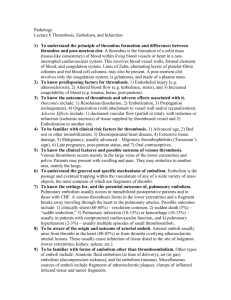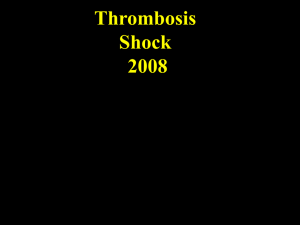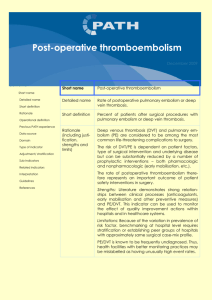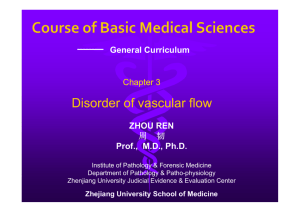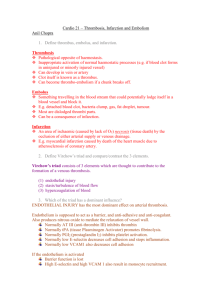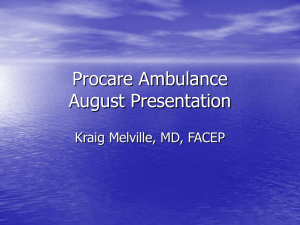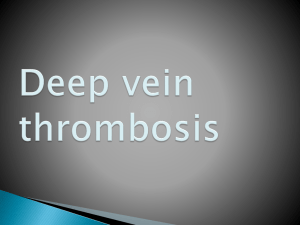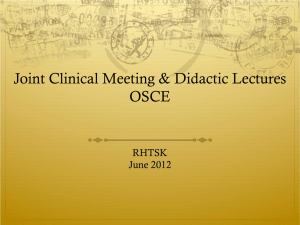Lecture 5
advertisement
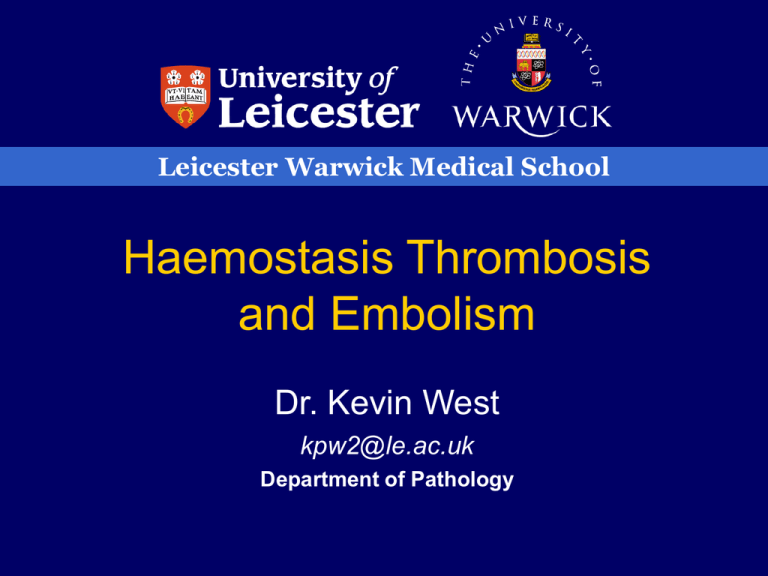
Leicester Warwick Medical School Haemostasis Thrombosis and Embolism Dr. Kevin West kpw2@le.ac.uk Department of Pathology Why don’t you bleed to death from a minor injury? Objectives 1 • Haemostasis Objectives 2 • Thrombosis – definition – predisposing factors – effects – outcomes – common clinical examples Objectives 3 • Embolism – – – – – – definition thromboembolism other types of embolism pathogenesis of DVT and pulmonary embolism pathophysiology of pulmonary embolism prevention and treatment of thrombo-embolic disease Haemostasis Successful haemostasis depends on • vessel wall • platelets • coagulation system • fibrinolytic system Blood Vessels • constrict to limit blood loss • arteries, veins, capillaries • mechanism not fully understood Platelets • • • • adhere to damaged vessel wall adhere to each other form a platelet plug platelet release reaction Platelet Release Reaction • ATP ADP • ADP, thromboxane A2 cause platelet aggregation • 5HT, platelet factor 3 also released • PF3 important in coagulation • Platelets coalesce after aggregation Coagulation • Cascade • Series of inactive components converted to active components • Prothrombin Thrombin Fibrinogen Fibrin Coagulation • 1 ml of blood can generate enough thrombin to convert all the fibrinogen in the body to fibrin • Tight regulation therefore required • Balance of procoagulant and anticoagulant forces Control of Coagulation • Thrombin destroys factors V and VIII • Thrombin inhibitors – anti-thrombin III* – alpha 1 anti-trypsin – alpha 2 macroglobulin – protein C and S* * inherited deficiency may thrombosis Fibrinolysis • Breakdown of fibrin • Plasminogen Plasmin Plasminogen activators • Fibrinolytic therapy widely used – streptokinase – tPA Endothelium • Anti-thrombotic – plasminogen activators – prostacyclin – nitric oxide – thrombomodulin Thrombosis • Definition Thrombosis is the formation of a solid mass of blood within the circulatory system Why does thrombosis occur? • Abnormalities of the vessel wall – atheroma – direct injury – inflammation Why does thrombosis occur? • Abnormalities of blood flow – stagnation – turbulence • Abnormalities of blood components – smokers – post-partum – post-op Appearances of thrombi • Arterial – – – – pale granular lines of Zahn lower cell content Appearances of thrombi Appearances of thrombi • Venous – – – – soft gelatinous deep red higher cell content Outcomes of thrombosis • Lysis – complete dissolution of thrombus – fibrinolytic system active – bloodflow re-established – most likely when thrombi are small Outcomes of thrombosis • Propagation – progressive spread of thrombosis – distally in arteries – proximally in veins Outcomes of thrombosis • Organisation – reparative process – ingrowth of fibroblasts and capillaries (similar to granulation tissue) – lumen remains obstructed Outcomes of thrombosis • Recanalisation – bloodflow reestablished but usually incompletely – one or more channels formed through organising thrombus Outcomes of thrombosis • Embolism – part of thrombus breaks off – travels through bloodstream – lodges at distant site Effects of thrombosis • Arterial – ischaemia – infarction – depends on site and collateral circulation • Venous – – – – congestion oedema ischaemia infarction Coronary artery thrombosis Coronary artery thrombosis Rudolf Virchow • b. Pomerania 1821 • graduated in medicine 1843 • presented work on thrombosis 1845 but could not get it published • founded own journal Rudolf Virchow • 1848 studied typhus epidemic in Prussia • Attributed typhus to poor social conditions which upset the government • Became a political activist and was sacked in 1849 after building barricades in Berlin uprising Rudolf Virchow • Appointed Professor of Pathology in Wurzburg • Described leukaemia, pulmonary embolism and much more • 1856 appointed Professor of Pathology in Berlin despite government opposition Rudolf Virchow • 1858 published ‘Cellular Pathology’ one of the most influential medical books ever written • 1880-93 Member of Reichstag • Died aged 81 after fracturing his hip jumping from a moving tram Embolism • Definition Embolism is the blockage of a blood vessel by solid, liquid or gas at a site distant from its origin. >90% of emboli are thrombo-emboli Embolism • Other types – air – amniotic fluid – nitrogen – medical equipment – tumour cells Thrombo-emboli • from systemic veins pass to the lungs = pulmonary emboli • from the heart pass via the aorta to renal, mesenteric, and other femoral arteries • from atheromatous carotid arteries pass to the brain • from atheromatous abdominal aorta pass to arteries of the legs Deep vein thrombosis • predisposing factors – immobility/bed rest – post-operative – pregnancy and postpartum – oral contraceptives – severe burns – cardiac failure – disseminated cancer Can DVT be prevented? • high risk patients must be identified and offered prophylaxis – heparin sub-cutaneously – leg compression during surgery Can DVT be treated? • intravenous heparin • oral warfarin Pulmonary embolism - effects • massive PE >60% reduction in bloodflow rapidly fatal • major PE - medium sized vessels blocked. Patients short of breath +/- cough and blood stained sputum • minor PE - small peripheral pulmonary arteries blocked. Asymptomatic or minor shortness of breath • recurrent minor PEs lead to pulmonary hypertension Pulmonary embolism


